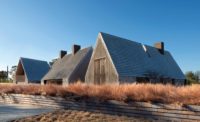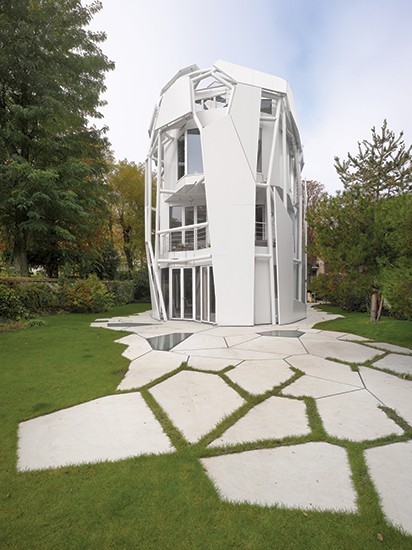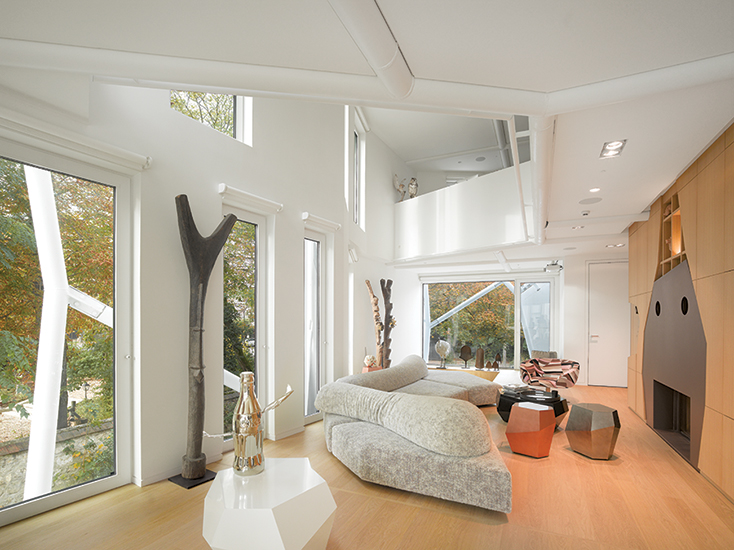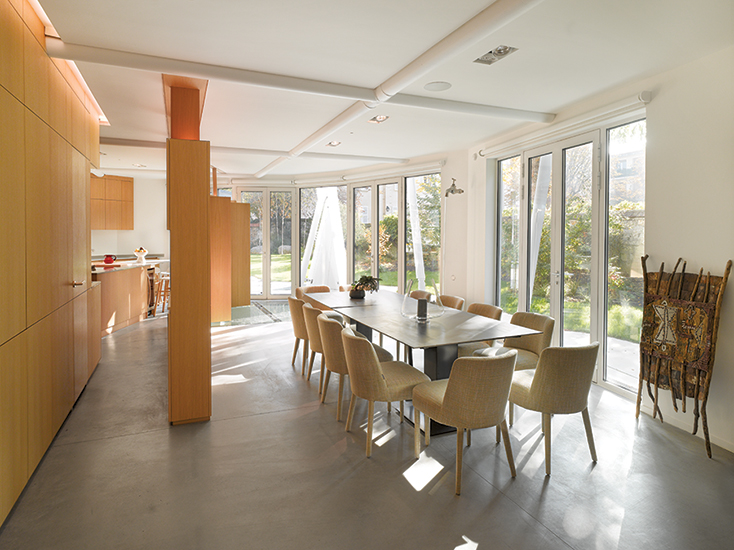The Connected House by Jakob + MacFarlane Architects
Boulogne-Billancourt, France

On the outskirts of Paris, the the white steel-tube-and-aluminum-panel structure quirkily fits into a mixed grouping of apartment houses, villas, and sports facilities.
Photo © Patrice Zito

The house opens onto a terrace at the rear of the property, where glazed sections among the concrete pavers allow glimpses of the swimming pool below.
Photo © Roland Halbe

In the two-story-high living level, elevated above the garage and dining and kitchen areas, a sectional sofa and a chair upholstered in Pucci fabric are arranged around the playfully designed fireplace.
Photo © Roland Halbe

At the street level, the garage, tucked within the white carapace of tubes and panels, is almost hidden.
Photo © Roland Halbe

The dining area and kitchen on the ground level are separated by built-in cabinets of French oak.
Photo © Roland Halbe

The stair at the entrance amply features this warm-colored wood, a contrast to the white metal bannisters and structure.
Photo © Roland Halbe

Image courtesy Jakob + MacFarlane Architects

Image courtesy Jakob + MacFarlane Architects

Image courtesy Jakob + MacFarlane Architects

Image courtesy Jakob + MacFarlane Architects

Image courtesy Jakob + MacFarlane Architects

Image courtesy Jakob + MacFarlane Architects

Image courtesy Jakob + MacFarlane Architects













Architects & Firms
The shimmering, white metal pavilion emerges from its leafy residential setting as a quirky apparition. The 8,600-squarefoot, four-story house sits on a ¼-acre property in Boulogne- Billancourt, an affluent suburb just west of Paris’s Bois de Boulogne. A block away is Le Corbusier’s Modernist apartment building Immeuble Molitor (1934), where the architect lived and had his office. Other avantgarde designers, such as Tony Garnier, August and Gustave Perret, and Robert Mallet-Stevens also left their mark in the district. “We felt this experimental 1930s tradition made our effort appropriate,” says Brendan MacFarlane, of the French firm Jakob + MacFarlane Architects. Designed as one of several homes for an active family with almost-grown children, the assembly of steel and aluminum appears organic, as if it had sprung from some strange, podlike plant. “We responded to the forest of trees all around,” says partner Dominique Jakob.
The two architects compare the division of spaces to a tree’s growth rings, although in this case, the rings are delineated by three architectonic zones: the stair and chimney; the interior volumes for living; and the space between those volumes and the exterior armature. “We also loved the idea of exposing the structure on the outside,” MacFarlane says about the tubular exoskeleton that supports the poured-concrete floors of the various levels. The design recalls the firm’s animated expansion (named Les Turbulences) of the FRAC Center, a contemporary art museum in Orléans (RECORD, October 2013). In both cases, Jakob + MacFarlane employed an aluminum skin and a structure of steel tubes, 6½ inches in diameter. But whereas all the tubes in the museum were tongue-and-groove joints created by digital laser cutting, in the house, the smaller intermediate tubes in the middle are bolted for the sake of economy.
The entrance to the vertically organized dwelling, facing a quiet street, is unprepossessing. But inside the vestibule, an open-riser stair, edged by oak bookshelves, thrusts dramatically up toward treetops glimpsed through high windows. An aquarium for tropical fish, built into the corner of the staircase, arrests your attention as you come into the ground level, where the dining room and kitchen extend out horizontally to a small landscaped garden at the rear. At the far end of the dining table is a small sitting area where you can look down through a glazed aperture in the floor to a swimming pool below. The effect is like gazing at a large aquarium for swimmers, an intriguing counterpoint to the smaller one at the entrance.
On the next level, the architects created a two-story height by cutting into the third floor to create an angled mezzanine for a home office. It, in turn, overlooks discrete sitting areas, including a sunken conversation pit. “The owners really like that 1960s look,” says MacFarlane, a predilection underscored by an undulating sectional sofa and a chair covered in Pucci fabric.
Bedrooms on the third and fourth levels can be reached by a small elevator as well as by the stair. Here, as elsewhere, the orthogonal plan dematerializes at the edges to yield oddly shaped terraces framed by tubes and offering bird’s-eye views of the neighborhood. “We wanted to see nature without being seen,” says the wife. “Also, light filters in everywhere in the house, from the pool to the double-height salon to our bedroom.”
An unassuming late 19th-century villa sits at the rear of the property, where an older couple have lived for a long time on the top two floors while the new owners use the villa’s lower levels for extra bedrooms and service spaces.
The architects physically linked these existing living quarters to the new house by a subterranean level containing the pool, an exercise area, and a screening room under the landscaped rear lawn and patio. You can see why Jakob + MacFarlane call this the “Connected House.” There are electronic ties as well: the latest security and mechanical controls let the owners stay connected even when they’re away. Three geothermal wells provide another link, literally to the earth, for heating and cooling.
While the project displays the latest in technical construction, the architecture seems to owe something to historical antecedents: the weblike tubes climbing the exterior evoke the early modern metalwork of the Art Nouveau architect Hector Guimard for his Paris metro stations, and Eugene-Emanuel Viollet-le-Duc’s V-shaped iron structural elements for his famous unbuilt concert hall of 1864. Whether or not Jakob + MacFarlane’s three-dimensional steel matrix for the domestic sphere will similarly inspire future architects, the integration of the machinelike and the organic is beguiling, if idiosyncratic.
CreditsArchitect: Jakob + MacFarlane Architects — Dominique Jakob and Brendan MacFarlane, partners; Romain de Santis, Thomas Sablayrolles, Axel Adam, Ken Sogawa, Antoine Heersant, team
Engineers: Batiserf (structural);
Consultant: Bollinger and Grohman (facade); Cap paysage (landscape)
|
SpecificationsMetal frame windows Schüco
Skylights Glazing Vision
Elevator Kone |



















